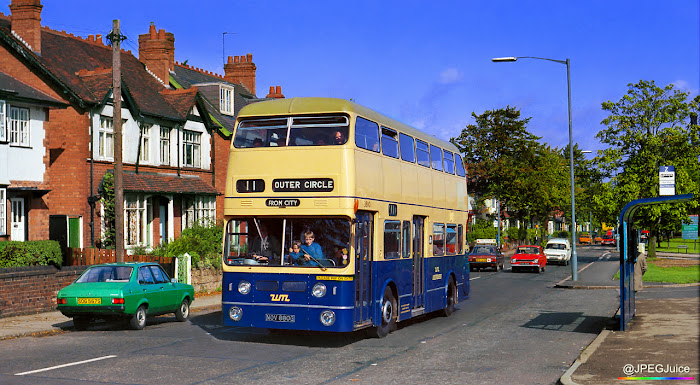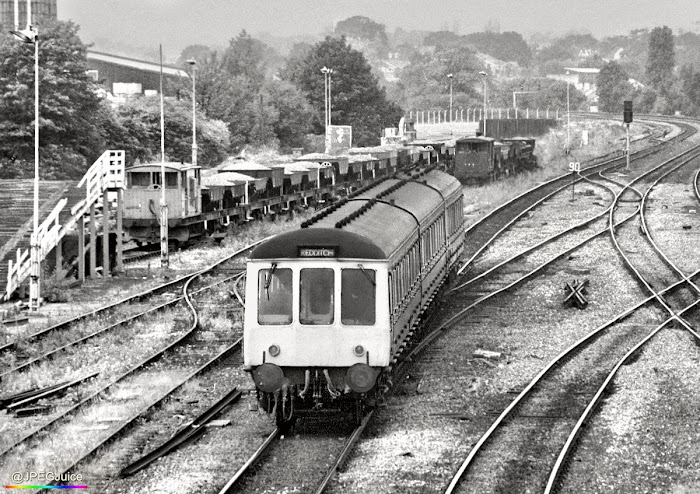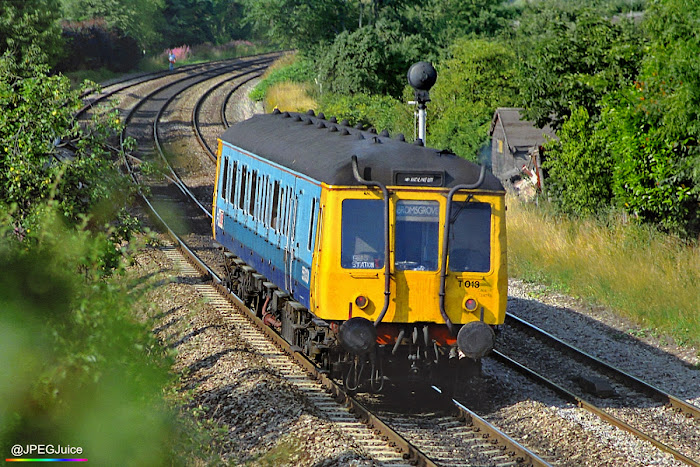"Ironically though, the lure of the new rail service took so many cars off the roads that the bus services initially speeded up!"

Bournville station was one of many locations that lost its best photographic vantage points when the electric wires were installed.
It’s funny the things we end up missing. If someone had told me when the West Midlands Cross-City line opened in spring ’78, that this was as good as travel between Longbridge and Four Oaks would ever get, I’d have categorised them as insane. And yet nothing has recaptured the charm of the Tyseley diesel mechanical units which characterised the first 15 years of Cross-City service. In this post I’m publishing some of my pictorial memories from the Cross-City’s diesel years, and summarising the story up until the point of electrification.

The view at Lifford in 1990, with a Class 116 car leading Tyseley set T319.
Before Cross-City rail services could begin, BR had some building work to attend to. On the south section, there was no existing station at University. Longbridge did have an old station, but it was on the former Halesowen branch inside the Austin motor works, and would have been impractical for use. It was therefore necessary to build Longbridge a new station on the main Birmingham to Gloucester line, from scratch. "Existing" stations on the south stretch needed varying levels of attention to render them fit for practical use. On the one hand you had Kings Norton, which was still serving passengers. On the other, you had Five Ways, which by the mid 1970s most rational observers would not regard as an existing station at all.
Longbridge station – the southern terminus and turnaround point – was not completed in time for the Cross-City launch, and never looked like being completed in time, since in early autumn 1977 construction work still hadn’t begun. The construction of University had, by contrast, been well underway in 1976.

Set T408 approaching Barnt Green. Due to their short remaining life-expectancy, it wasn't really worth bothering to repaint these units into 1980s provincial colours. Rail Blue and grey remained the norm into the 1990s.
Longbridge consequently opened with its northbound platform accessed via a precarious looking temp wooden ramp, staff selling/collecting tickets from portacabins, etc. The original tickets were made from till-roll thin, pallid pink paper, and were issued from Longbridge using hand-held, bus conductor style machines. My daily child fare ticket from Longbridge to Northfield cost 4p in the earliest phase of the station’s life.
But regardless of any unreadiness, the full opening pressed ahead as scheduled on Monday 8th May 1978. It essentially launched as a frequent Longbridge to Four Oaks service (and vice versa), with BR Chairman Sir Peter Parker among the route’s first-day passengers. Select services continued to Lichfield City at the north end, and at the south there was also the odd service from or to Redditch/Bromsgrove during peak hours. Despite the almost universal use of first generation diesel mechanical units, and scathing press relating to the age of the trains, the service was an instant, raging success.

The competition. A WMPTE Daimler Fleetline of the type that directly competed with early Cross-City rail services between Longbridge and Birmingham city centre.
Tyseley’s core fleet of Class 116s may have taken a good 20 seconds to reach anything above walking pace upon station departure, but they were still hugely preferable to WMPTE’s public road transport of 1978. They’re a nostalgic sight today, but nausea-inducing Daimler Fleetline buses – themselves built in the 1960s – lurching along in heavy rush hour traffic, interiors fogged with a mix of cigarette smoke and exhaust seepage, were not a pleasant experience.
Ironically though, the lure of the new rail service took so many cars off the roads, that the bus services initially speeded up. Midland Red buses, with fewer stops than WMPTE, were generally faster than the trains between Longbridge and Birmingham in the early years of the Cross-City line.

Although upon launch some Tyseley 116s had been refurbished into WMPTE white, the bulk of the sets were still in all over Rail Blue.
Upon launch of the Cross-City, Tyseley’s 116 units were part-way through a refurbishment programme, which heavily modified the interiors. Unrefurbished 116s featured the old suburban compartment plan, with no walkthrough facilities. The compartments were of different sizes – some as small as a single bay. And the only way into or out of a compartment, was off or onto a station platform. The walls were solid. No corridors, no interconnecting doors.
These interiors may have been acceptable when the trains were built, but they were clearly not safe in the event of fire or other emergencies. Additionally, teenage gangs used the compartments as bullying traps; women in particular found the arrangement scary – especially late at night in an era before cellphones; and guards/inspectors could not effectively police fare-dodging.

In the 1970s, the PTE white livery was used across the country for refurbished DMUs. In general, each local PTE applied its own branding in place of the BR double arrow. It was the first departure from BR corporate identity since the 1960s.
So refurbishment installed interconnecting doors to establish internal walkthrough access. Later refurbs dispensed with the interconnecting doors altogether to essentially make each coach into a single open space – albeit still with the remnants of the old compartment divisions.
In the late 1970s, the unrefurbished units were all-over BR blue, whilst the fully refurbished units were “WM” branded PTE white. However, some all blue vehicles had partially modified interiors with internal compartment access doors, so the livery wasn’t always an indicator of a non-walkthrough set. From around spring 1982, BR stopped applying the PTE white livery to the Tyseley 116s, and began to outshop them in standard Rail Blue and grey stock colours. From then on, the revision of all 116 units into standard blue and grey was swift.

Kings Norton station was in use before the Cross-City opened, but it was not brought up to spec with full facilities in time for launch.
One of the joys of riding on a 116 unit (or similar), whether before or after refurb, was the prospect of being able to see the driver’s eye view from the front passenger seats. The windows between cab and passenger compartment were normally fitted with blinds, but drivers often didn’t draw them, which meant the passengers in the seats behind the cab could see both the view ahead, and how the unit was driven. With only a thin wall between cab and passenger compartment (and the door sometimes left ajar), passengers near the front could also hear all of the AWS warnings and brake sounds.

I know! 50009 Conqueror on the 08:09 ex-Longbridge of Monday 20th April 1981.
From the start of the Cross-City, one northbound service per day between Longbridge and New Street was loco-hauled. The train departed Longbridge at 08:10, Northfield at 08:13, and Kings Norton at 08:16. It came from Gloucester in the week and Worcester on a Saturday – and it went forward to Leeds until 1980. It’s seen above at Longbridge, very unusually in the hands of a Class 50 on Easter Monday 1981, by which time its scheduled departure was 08:09. The train’s staple power was a ‘Peak’, but by this time, loco-haulage on the Cross-City was on its last legs.
From the May 1984 timetable change (14th of the month), the Cross-City service was intensified, giving a nod to the huge importance of this still fairly new hive of local travel. But trains were still not extended to Lichfield Trent Valley at the north extreme. TV did not become the ultimate northern terminus until the high level platforms re-opened on 28th November 1988.

The Class 116s had a 'skinhead' appearance from the front end, with only a small destination indicator as opposed to a headcode box.
The use of diesel units on the route divided into two broad eras. The first era lasted from 1978 to 1986, and saw the Class 116 very definitively operating as the Cross-City’s staple DMU type. Note, however, that the 116s never had an exclusive grip on services. In the early 1980s, there was stock from classes 100, 101, 104, 105, 116, 117 (unpowered vehicles only), 122 and 127 (unpowered vehicles only) based at Tyseley, and any of this could turn up on the Cross-City line. So the 116s were the designated and very dominant type, but that ideal was punctuated by occasional appearances from the other variants. On very rare occasions you might see a Class 120 (likely on loan from Derby) on a Cross-City service. And the Class 210 demonstrator notably trialled on the Cross-City in that period too.

The slow crawl out of University station. Who could ever forget it?
The second broad era lasted from 1987 until the end of diesel service, and saw a range of units decanted from the South East replacing many of the 116s. The decanted stock included representatives from Classes 115, 117, 118 and 127. All of these units were very similar to the 116s, but there was a glaringly obvious sign of their arrival: headcode boxes. The Class 116 era was defined by a ‘skinhead’ look, with just a small route indicator box above the cab front. But when the ex-South East units moved in, there was an increasing prevalence of that characteristic large, redundant headcode box in the same position above the cab.

A mixed set leaving Northfield station, led by a Class 116 fronting set T328.
Whilst initially the replacement units worked in their WR sets, and continued to carry their WR set numbers for a while, the vehicles were soon jumbled up, so that many of the units on the line could no longer be identified as one specific class. Class 116 vehicles continued to appear mixed in with the rest. The new era also rendered four-car sets a common sight. Previously, the overwhelmingly dominant formation types had featured either three or six cars.

Tyseley 'Bubble Car' 55033 on the Barnt Green - Bromsgrove shuttle in summer 1990.
Tyseley also retained Class 121 and 122 ‘Bubble Cars’ in this era, but they were normally set aside for specific duties, like the Bromsgrove – Barnt Green shuttle, and ‘Bubble Cars’ tended not to be tagged onto Cross-City sets as they’d sometimes been in earlier years.
The start of the second era roughly coincided with BR’s allocation of numbered levels to repair and maintenance facilities. In April 1987, Tyseley officially became a Level 4 facility for DMU servicing, meaning it could carry out most routine repairs as well as all types of exam. It was authorised to carry out full maintenance on Classes 101, 108, 116 and 121, plus the trailer cars for Classes 111, 115 and 127.

After much lobbying and speculation, electrification of the Cross-City line was eventually approved on 7th February 1990. The news not only heralded the end of the diesel mechanical unit on this busy line, but the destruction of many photographic vantage points. It’s hard to believe today that the above shot was taken on the Cross-City line, but this is how the non-urban section between Barnt Green and Longbridge looked before electrification.
Electric services started on the north section of the Cross-City, with the 17:28 Birmingham – Blake Street of 26th November 1992. The line officially became fully electric from Monday 12th July 1993. The DMUs’ initial replacements were primarily vintage EMUs from Classes 304, 308 and 310. The plan had been to directly replace the diesel mechanical units with brand new Class 323s, but very heavy delays in the introduction of the latter saw the vintage EMUs ruling the roost for well over a year. In fact, cursory use of vintage EMUs on the Cross-City persisted well into the privatised era, and was finally ended by Central Trains in the second half of 1999. There’s a shot of a 310 on the Cross-City in ’99 in the Central Trains Class 310 article.

A reminder that Longbridge was not only a terminus on the Cross-City line, but also a destination for freight traffic into the Rover motor plant. An RfD Class 47/0 storming up past a ‘mongrel’ diesel unit in the turnaround siding was a familiar sight indeed here at Longbridge Lane in 1990. Just up the road at Kings Norton the 47 would run round its train of parts from Swindon, and head back to Longbridge, by which time it would be travelling in the right direction to access the Rover factory branch. The DMU would form the next service for Four Oaks.
Nostalgia always tends to spin a positive, blotting out the reality that diesel-mechanical-powered Cross-City services could prove infuriating at times. But I'd be prepared to bet that if we timewarped back to the 1980s for a one-day dose of the above, we'd end that one day asking if we could stretch it out to a week... Or a month... Or a sci-fi style timeloop in which the 323s never actually arrive...
